Constitution as a Living Document – Complete Guide For Class 11 Political Science Chapter 9
Welcome to iPrep, your Learning Super App. Our learning resources for the chapter, “Constitution as a Living Document” in Political Science for Class 11th are designed to ensure that you grasp this concept with clarity and perfection. Whether you’re studying for an upcoming exam or strengthening your concepts, our engaging animated videos, practice questions and notes offer you the best of integrated learning with interesting explanations and examples.
In a nation as diverse and dynamic as India, the Constitution serves as a beacon of stability and adaptability. The chapter Constitution as a Living Document in your Political Science curriculum provides an in-depth look at how this foundational document is more than just a set of laws—it’s a living, breathing entity that evolves with the country.
This chapter explores how the Constitution has been amended over time to reflect the changing aspirations and needs of the Indian people. By diving into the processes of constitutional amendments, the concept of its basic structure, and the role of the judiciary, you’ll gain a deeper understanding of why the Constitution remains a vital and adaptable tool for governance. With the iPrep Learning Super App, you’ll have access to rich resources that will make exploring these concepts both enlightening and engaging.
Constitution as a Living Document
This chapter explores the dynamic nature of the Indian Constitution and how it has evolved. It discusses the mechanisms for amending the Constitution, the reasons behind numerous amendments, and the role of the judiciary in shaping its interpretation. The chapter also examines the concept of the basic structure of the Constitution and its implications for constitutional amendments.
The Indian Constitution, a cornerstone of the nation’s democracy, is not a static document. It has undergone significant changes and adaptations since its adoption in 1950. This chapter delves into the mechanisms through which the Constitution can be amended, the reasons behind these amendments, and the evolving nature of its interpretation. By understanding how the Constitution has evolved, we can appreciate its adaptability and its ability to respond to the changing needs of the nation.
Objectives Of Learning The Chapter
Now that we have explored the importance of the chapter, let’s outline the objectives of studying it.
- To understand the mechanisms for amending the Constitution.
- To analyze the reasons behind the numerous amendments made to the Constitution.
- To explore the concept of the basic structure of the Constitution.
- To examine the role of the judiciary in shaping the interpretation of the Constitution.
- To appreciate the dynamic nature of the Constitution and its ability to adapt to changing circumstances.
Now let’s explore the various sections of the chapter.
Firstly, to understand whether constitutions are static, let’s delve into the section Are Constitutions Static? of the chapter Constitution as a Living Document.
Are Constitutions Static?
- The Indian Constitution, like many others, is not a static document. It is designed to be flexible and adaptable to changing circumstances.
- This is evident in the various amendments that have been made to it over the years. However, the question arises: how can a constitution be both flexible and stable?
Now, to understand the amendment process, let’s delve into the section How to Amend the Constitution? of the chapter Constitution as a Living Document.
How to Amend the Constitution?
The Indian Constitution provides for two methods of amendment:
- Simple Majority: Most amendments can be made by a simple majority of the members of both Houses of Parliament.
- Special Majority: Certain amendments, such as those relating to fundamental rights or the procedures for amending the Constitution itself, require a special majority. This involves a two-thirds majority of the members present and voting in each House and ratification by at least half of the states.

Special Majority
A special majority is required for amendments that affect:
- Fundamental rights
- The procedures for amending the Constitution
- The Union List, State List, or Concurrent List
- The composition of the Houses of Parliament
- The Rajya Sabha
- The President
- The Supreme Court or the High Courts
Ratification by States
Certain amendments, particularly those that affect the federal structure of India, require ratification by at least half of the states. This ensures that the states have a say in the amendments that affect their powers and autonomy.
Now, to understand the frequency of amendments, let’s delve into the section Why Have There Been So Many Amendments? of the chapter Constitution as a Living Document.
Why Have There Been So Many Amendments?
The Indian Constitution has undergone numerous amendments over the years. This is due to a variety of reasons, including:
- Changing needs of the nation: As India has developed and evolved, the Constitution has needed to adapt to meet the changing needs of its people.
- Political considerations: Amendments have sometimes been made for political reasons, such as to address party interests or to appease certain groups.
- Judicial interpretations: Court decisions have sometimes led to amendments to clarify or modify the Constitution.

The key points covered under this topic are discussed below.
Contents of Amendments Made So Far
The amendments made to the Indian Constitution cover a wide range of topics, including:
- Fundamental rights: Amendments have been made to expand or limit fundamental rights.
- Directive principles of state policy: Amendments have been made to clarify or strengthen the directive principles.
- Federalism: Amendments have been made to address issues related to federalism, such as the division of powers between the Union and the states.
- Economic policy: Amendments have been made to address economic issues, such as land reforms and nationalization of industries.
- Social justice: Amendments have been made to address issues of social justice, such as affirmative action for marginalized groups.
Differing Interpretations
The interpretation of the Constitution is not always straightforward. There may be differing interpretations among different judges, political parties, and citizens. This can lead to debates and controversies over the meaning and application of the Constitution.
Amendments through Political Consensus
In many cases, amendments to the Constitution have been made through political consensus. This means that the government and the opposition parties have agreed on the need for an amendment and have worked together to pass it.
Controversial Amendments
Some amendments to the Constitution have been controversial. This is often due to concerns about their impact on fundamental rights, federalism, or other important principles.
Now, to understand the concept of the basic structure, let’s delve into the section Basic Structure and Evolution of the Constitution of the chapter Constitution as a Living Document.
Basic Structure and Evolution of the Constitution
The concept of the basic structure of the Constitution is important. It refers to the core principles and values that are essential to the Indian Constitution. These principles cannot be amended or altered.
The basic structure of the Constitution has evolved. The Supreme Court has played a key role in defining and protecting the basic structure.
Now, to understand the Constitution’s adaptability, let’s delve into the section Constitution as a Living Document of the chapter Constitution as a Living Document.
Constitution as a Living Document
The Indian Constitution is a living document. It is constantly evolving and adapting to the changing needs of the nation. This adaptability is essential for a democracy to function effectively.
The key points covered under this topic are analyzed below.
Contribution of the Judiciary
The judiciary has played a crucial role in shaping the interpretation and application of the Constitution. Through its decisions, the judiciary has helped to protect fundamental rights, uphold the federal structure, and ensure that the Constitution remains relevant to the needs of the nation.
Maturity of the Political Leadership
The maturity of the political leadership is also important for the effective functioning of the Constitution. It is essential for political leaders to respect the Constitution and to work together to uphold its principles.
Finally, as we have gained comprehensive knowledge about the chapter “Constitution as a Living Document“, let’s reflect on the overall learning value of this important lesson.
Overall Learning Value of the Chapter
This chapter has provided a comprehensive overview of the Indian Constitution as a living document. It has discussed the mechanisms for amending the Constitution, the reasons behind numerous amendments, and the role of the judiciary in shaping its interpretation. By understanding how the Constitution has evolved, we can appreciate its adaptability and its ability to respond to the changing needs of the nation.
In conclusion, the CBSE Class 11th Political Science Chapter, Constitution as a Living Document, offers a profound understanding of the dynamic nature of the Indian Constitution. It emphasizes how the Constitution’s adaptability ensures it remains relevant in addressing the evolving needs of the nation. Through mechanisms like amendments and the judiciary’s role in interpretation, we see how the Constitution is not static but constantly evolving. The chapter, Constitution as a Living Document, encourages students to appreciate the balance between flexibility and stability within the framework of Indian democracy. With iPrep, your Learning Super App, mastering such concepts becomes more engaging and effective!
Practice questions on Chapter 9 - Constitution as a Living Document
Get your free Chapter 9 - Constitution as a Living Document practice quiz of 20+ questions & detailed solutions
Practice Now








